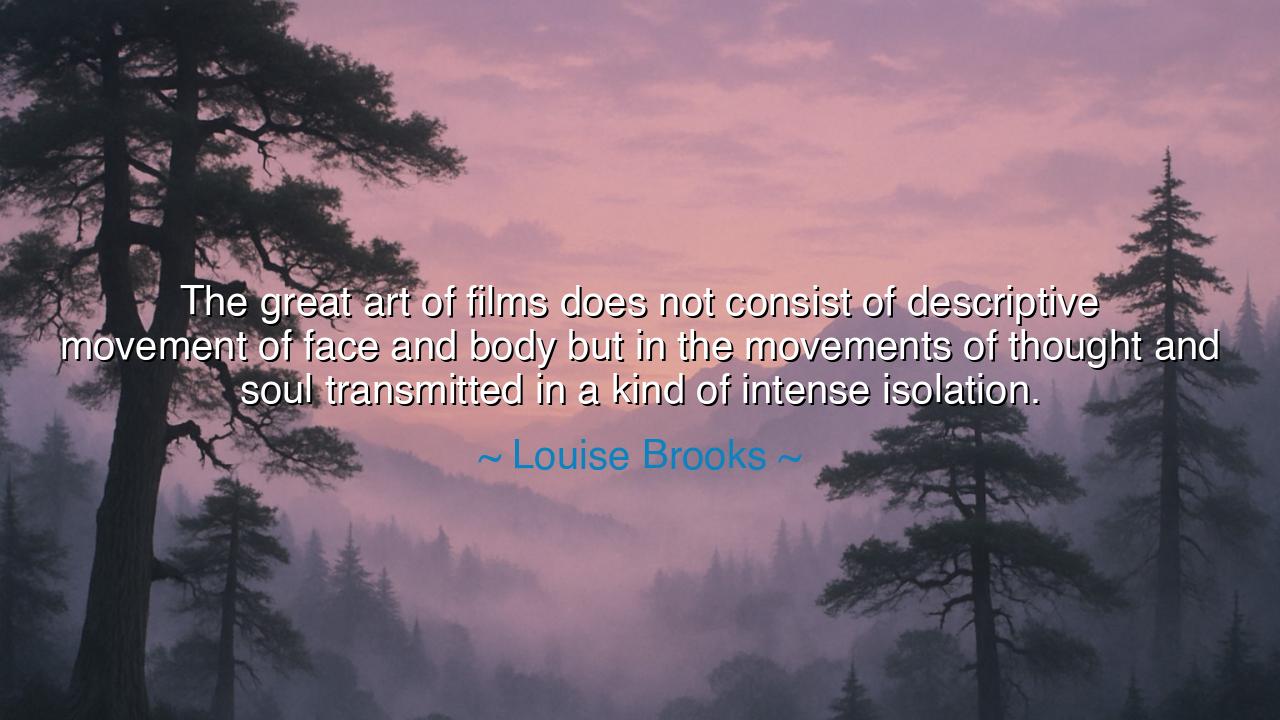
The great art of films does not consist of descriptive movement
The great art of films does not consist of descriptive movement of face and body but in the movements of thought and soul transmitted in a kind of intense isolation.






When Louise Brooks declared, “The great art of films does not consist of descriptive movement of face and body but in the movements of thought and soul transmitted in a kind of intense isolation,” she lifted the veil from cinema’s truest essence. Her words cut through the illusion that acting is merely the dance of gestures and expressions. Instead, she reveals that the power of film is born from the unseen currents within—the movements of thought and soul—that radiate from an actor in silence, in stillness, in those moments when no word is spoken, yet the entire heart of a character is made visible.
The origin of this wisdom lies in Brooks’s own experience. As one of the great actresses of the silent era, she understood better than most that cinema is not theater. The stage requires voice and gesture to reach the back rows; film requires something deeper, more inward. Before the unblinking eye of the camera, no exaggerated gesture can suffice. Instead, what compels the viewer is the inner life shining through the eyes, the intensity of thought, the trembling of the unseen soul. Brooks knew this from her iconic role in Pandora’s Box, where she embodied despair, longing, and innocence not through loud theatrics but through a quiet, haunting presence that has endured across generations.
History bears witness to her truth. Think of Maria Falconetti in Carl Theodor Dreyer’s The Passion of Joan of Arc. Her face, nearly bare of expression, conveyed a depth of suffering and transcendence that shook audiences to their core. It was not the movement of her body that burned itself into film history, but the fire of her spirit shining through her eyes in near silence. Here we see what Brooks described: cinema as an art of soul in isolation, where the actor’s inner world speaks more eloquently than words or gestures ever could.
The meaning of Brooks’s insight is that true film acting is paradoxical: it thrives not in the abundance of expression, but in the restraint of it. The camera captures what cannot be faked—the authentic stirring of thought, the quiet tremors of emotion, the depth of a human being confronting life in all its mystery. This is why an actor may move little, yet move the world; why a single glance can wound or heal more than a page of dialogue. The art of film is the art of transmitting the invisible.
The lesson is one that transcends cinema. In life itself, people are not moved most deeply by grand displays, but by authentic presence. A friend’s silent companionship in grief may carry more weight than a thousand words. A leader’s quiet resolve may inspire more than thunderous speeches. So too, in film, it is not the showy gesture but the truth of the soul that lingers in memory. Brooks reminds us that the greatest art—and the greatest humanity—lies in depth, not in display.
What, then, should you do? First, when you watch a film, look beyond the surface of movement and words; seek the inner current of soul flowing beneath. Second, when you create—whether in art, work, or relationship—do not rely only on outward performance. Cultivate the authenticity within, for it is this inner truth that transmits itself most powerfully to others. Third, remember that isolation need not mean emptiness; it can be the crucible where the soul becomes visible.
Thus, let Louise Brooks’s words stand as a beacon: “The great art of films… lies in the movements of thought and soul.” This is not only a lesson for actors but for all who seek to live truthfully. For in every life, as in every frame of film, there are moments when gestures fade, when words fall silent, and only the soul can speak. And it is in those moments, stripped bare of pretense, that true greatness shines.






AAdministratorAdministrator
Welcome, honored guests. Please leave a comment, we will respond soon